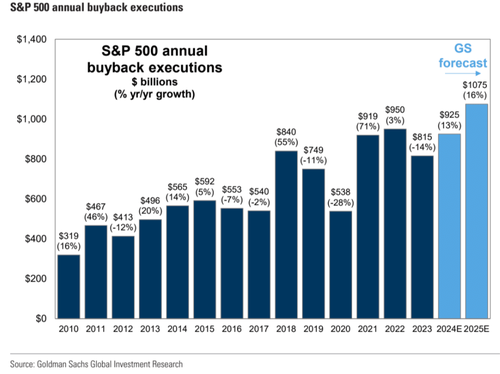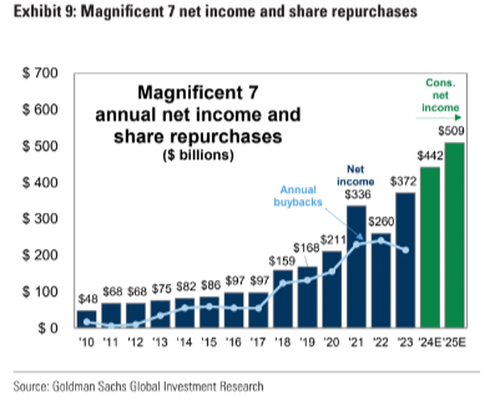Goldman Sees Stock Buybacks Topping $1 Trillion For First Time, Driven By Mega-Cap Giants
Analysts at Goldman Sachs forecast that companies in the S&P 500 will buy back $925 billion in stock in 2024, and this number is expected to exceed $1 trillion by 2025. This increase in stock buybacks is mainly attributed to solid earnings from big tech firms and a possible resolution of political uncertainty surrounding the US presidential elections.
“We raise our 2024 buyback forecast and introduce a forecast for 2025. We forecast that S&P 500 repurchases will total $925 billion in 2024 (13% yr/yr growth) and $1,075 billion in 2025 (16% yr/yr growth),” analysts Cormac Conners and David Kostin wrote in a note to clients.
The analysts continued, “Solid earnings growth will be the primary tailwind to buybacks, while elevated valuations and policy uncertainty will be headwinds. We expect buyback growth in 2024 to be driven largely by mega-cap tech stocks.”
The surge in expected buybacks this year and next comes after repurchases plunged 14% in 2023, the second-largest annual decline since the Global Financial crisis.
Conners upgraded GS’ S&P500 forecast for 2024 ($241 EPS, 8% growth) and 2025 ($256, 6% growth) due to improving macroeconomic conditions and stronger-than-expected mega-cap tech margins and earnings.
“The broader macro environment since the fall, like the decline in Treasury yields, also helps to inform our forecast upgrade,” the analyst said.
“Rich valuations and elevated policy uncertainty indicate S&P500 buybacks will grow by slightly less in 2024 than our earnings forecast alone implies,” Conners said, adding:
- First, management teams are less likely to deploy cash into repurchases when their shares trade at elevated valuations. The median S&P 500 stock trades at 18x today (87 th percentile since 1990) while the aggregate index trades at 20x (86 th %-ile). We expect multiples will remain near these elevated levels throughout 2024.
- Second, history suggests the November general election will lead to elevated policy uncertainty in 2H 2024, incentivizing companies to postpone large increases in buybacks until 2025.
Also, improving profit growth and expectations of an interest rate cut from the Federal Reserve in June add to bullish animal spirits among investors, suppressing VIX and catapulting the S&P500 to record highs. According to the analyst, this improving environment will send S&P 500 buybacks above the trillion dollar mark for the first time next year.
They noted the bulk of the buybacks will be from big tech companies:
“Revenue growth for the sectors will be supported by strong consumer spending and increased demand for AI-related products. A continued focus on improving operating efficiency will drive further margin expansion. Info-Tech remains the single largest source of repurchases for the index while Communication Services is the third largest sector for repurchases, behind Financials.”
The Magnificent 7, consisting of Apple, Meta Platforms, Alphabet, Microsoft, Tesla, NVIDIA, and Amazon, will likely drive a substantial portion of S&P 500 buyback growth this year and next. Recent filings show this group had already authorized $215 billion in stock buybacks this year, 30% higher than the level authorized at the same time last year ($166 billion).
“The group’s continued rapid revenue growth should be sufficient to fund AI investments in the coming years without hindering capital return to shareholders,” the analysts said.
They continued, “The group spent $407 billion on capex and R&D in 2023, representing 23% of their annual revenue and 27% of all S&P 500 capex and R&D. Capex and R&D will top $500 billion in 2025 if spend grows in line with consensus estimates for revenue growth (12% CAGR).”
And this is very important for the future of buybacks:
“If management teams see attractive investment opportunities beyond this growth in spend, they may limit growth in buyback programs in order to fund investment. However, the sheer scale of their existing capex and R&D spend and the group’s increased focus on operating efficiency suggests this is unlikely,” the analysts said.
During Thursday night’s State of the Union address, President Biden proposed tripling the current buyback tax on corporations. This move would force executives to spend more cash on workers and factories instead of rewarding shareholders.
And moar buybacks, please, as Bloomberg macro strategist Simon White sees the market “entering its topping phase.”
More of the note is available to pro subscribers.
Tyler Durden
Fri, 03/08/2024 – 11:05
via ZeroHedge News https://ift.tt/wu6ZO3G Tyler Durden

